Introduction
Front
{{section_header}}{{section.name}}{{/section_header}}
The front of the Sony KDL-46BX420 has a standard flat glossy black bezel, with very subtle features, like a tiny power indicator light and logo.

Back
{{section_header}}{{section.name}}{{/section_header}}
The back of the Sony KDL-46BX420 is a boring-looking black plastic casing with a small panel on the right side for ports.

Sides
{{section_header}}{{section.name}}{{/section_header}}
The sides of the KDL-46BX420 are home to the manual controls (on the right side) and a side-oriented input panel.

Stand/Mount
{{section_header}}{{section.name}}{{/section_header}}
The included stand of the KDL-46BX420 is a relatively basic affair that can be a pain to set up with at least one unnecessary piece. As with all high-gloss plastic, this stand gathers fingerprints much like a hoarder would if they could hoard fingerprints.

Controls
{{section_header}}{{section.name}}{{/section_header}}
The manual controls for the KDL-46BX420 are located on the right side of the set, and as you can see from the picture, they are quite tiny and very poorly marked. We know manual controls are hardly used anymore, but these are near-impossible to use in the dark unless you've memorized their positions beforehand.

Remote Control
{{section_header}}{{section.name}}{{/section_header}}
The KDL-46BX420's remote control is fairly basic, as it's not really needed to do much other than operate a TV without internet features. It fits in the hand well, and the buttons are nice and large while being easy to press.

In the Box
{{section_header}}{{section.name}}{{/section_header}}
Included in the packaging for the Sony KDL-46BX420 is an instruction manual, setup instructions, remote, battery and a stand.
Black Level
{{section_header}}{{section.name}}{{/section_header}}
As you can see from the comparison chart below, the Sony KDL-46BX420 has an excellently low black level of 0.04 cd/m2. Typically, we see this kind of performance from a plasma screen TV, but not an entry-level LCD screen. Good job Sony! More on how we test black level.
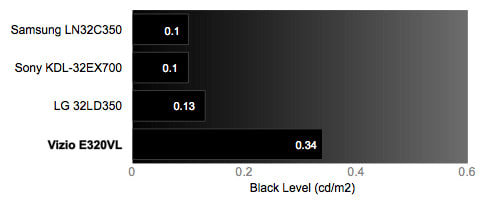
Peak Brightness
{{section_header}}{{section.name}}{{/section_header}}
The Sony KDL-46BX420 didn't struggle at all in displaying a bright screen, as it recorded a peak brightness of 298.64 cd/m2. Really, any TV set that can display a screen brighter than 200 cd/m2 or higher will be sufficient for viewing in a well-lit room, so don't read too much into the fact that the KDL-46BX420 doesn't have the brightest screen we've ever seen. More on how we test peak brightness.
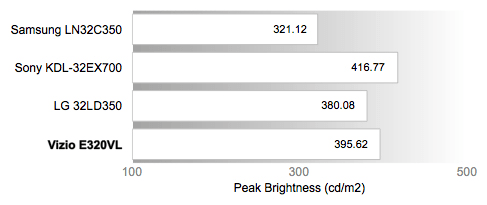
Contrast
{{section_header}}{{section.name}}{{/section_header}}
Due to the great black level and decently high peak brightness, the Sony KDL-46BX420 has an outstanding contrast ratio of 7466:1 which dwarfs the comparison models, and most of the competition. While you probably won't notice much of a difference between other TVs at the store, the difference becomes much more apparent when you put them side-by-side in a dark room. More on how we test contrast.

Tunnel Contrast
{{section_header}}{{section.name}}{{/section_header}}
Like most LCD screens, the Sony KDL-46BX420 had no trouble maintaining a consistent black level on the screen no matter how much or how little area was displayed in black or white. More on how we test tunnel contrast.
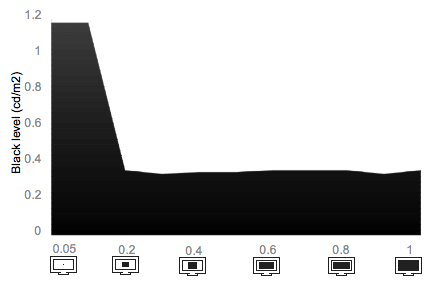
White Falloff
{{section_header}}{{section.name}}{{/section_header}}
Likewise, there was no issue with white falloff either, with the Sony KDL-46BX420 maintaining a consistent brightness level no matter how much or how little area of the screen was displayed as black or white. More on how we test white falloff.
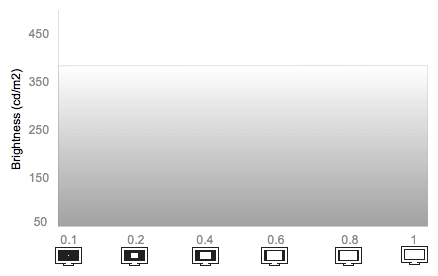
Uniformity
Greyscale Gamma
{{section_header}}{{section.name}}{{/section_header}}
The Sony KDL-46BX420 did a fair job in our greyscale gamma testing, showing no points along the range of measured signal intensity where the TV could not produce a certain shade. You'll notice though, that the score isn't perfect here, which is due to the second way in which we rate greyscale gamma performance: slope of the line.
Because every single TV is given the same exact test, we know that an ideal response from any TV we test should give us a line with a slope of 2.1 to 2.2, but we find that often this doesn't happen for one reason or another. The Sony KDL-46BX420 gave us a line with a slope of 2.65, which isn't great by any stretch of the imagination, but not horribly bad either. Chances are good that you won't notice much of an impact in detail at all, but the possibility is greater that there will be a tiny errors in shadow. More on how we test greyscale gamma.
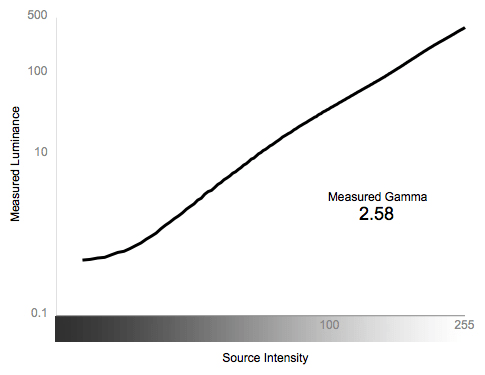
Color Temperature
{{section_header}}{{section.name}}{{/section_header}}
The Sony KDL-46BX420 did a great job in maintaining an accurate color temperature throughout the entire range of signal intensity, despite its slight flare towards the darkest end of the spectrum. Given that the error levels very rarely stray into the limit at which it's possible for the human eye to detect, we can tell you that you will almost never notice this being a problem, even if you're looking for it. More on how we test color temperature.

RGB Curves
{{section_header}}{{section.name}}{{/section_header}}
The Sony KDL-46BX420 has nice, smooth RGB curves that are relatively tightly in-line with each other, meaning that the TV has little trouble displaying the correct values of each color along the greyscale. Overall the KDL-46BX420 scored well here. More on how we test RGB curves.

Below are linear representations of each RGB curve as compared with the color values of each comparison model TV set.
Motion Performance
{{section_header}}{{section.name}}{{/section_header}}
The Sony KDL-46BX420 actually didn't do too badly with displaying a smooth motion performance, maintaining a nice level of detail in motion and no issues that we normally see in refresh rate with entry-level TVs. There was an appreciable amount of artifacting in every single one of our test patterns, and no feature to really deal with this. Still, the overall performance was good, so the Sony KDL-46BX420 shouldn't disappoint in this area. More on how we test motion performance.
3:2 Pulldown & 24fps
{{section_header}}{{section.name}}{{/section_header}}
The Sony KDL-46BX420 had a few minor issues with 3:2 pulldown and 24fps content, despite its additional video processing feature to specifically deal with this. While it handled film content in an acceptable manner, it didn't seem to handle high-frequency patterns all that well, showing a little bit of strobing that was mostly fixed by its Cinemotion video processing feature when turned on. More on how we test 3:2 pulldown and 24fps.
Resolution Scaling
{{section_header}}{{section.name}}{{/section_header}}
The Sony KDL-46BX420 has a native resolution of 1080p, but can display all standard NTSC resolutions, but performance changes with content from each resolution to another. Below is a summary of performance issues in the most common resolutions. More on how we test resolution scaling.
480p
The Sony KDL-46BX420 lost 2% of its screen vertically and 3% horizontally to overscan, and showed absolutely no issues in our other resolution tests.
720p
The set lost 2% of its screen area vertically and horizontally to overscan, and displayed significant troubles with high frequency patterns.
1080i
The KDL-46BX420 lost no screen area to overscan and performed remarkably well in our other resolution tests.
Formats
{{section_header}}{{section.name}}{{/section_header}}
The Sony KDL-46BX420 has a native resolution of 1080p and can display all standard NTSC resolutions.
Viewing Angle
{{section_header}}{{section.name}}{{/section_header}}
If there is an Achilles' heel of LCD screens, it is the fairly universally bad viewing angle they they typically have; if there is a glaring weakness of the Sony KDL-46BX420 in particular, this would be it. While we don't expect that LCD screens will have viewing angles that rival those of a plasma screen, the viewing angle of the Sony KDL-46BX420 was particularly bad, only maintaining over 50% of its contrast ratio from 16 degrees from the center of the screen on either side. We've seen worse viewing angles, but not many.

Reflectance
{{section_header}}{{section.name}}{{/section_header}}
Another glaring (get it?) issue with the Sony KDL-46BX420 is the screen reflectance. Despite LCD screens typically being better at diffusing and minimizing reflected light in the screen than plasmas (which are almost mirror-like in comparison), the Sony KDL-46BX420 somehow managed to make the reflectance even more annoying than the worst plasma screens we've seen. Using the same exact source of light we've used to test every other TV, the reflection pattern was huge and bright, often obscuring almost half of the screen in an even glow. If there are bright sources of light near where you are planning to put your Sony KDL-46BX420, strongly reconsider which model TV you purchase.
Video Processing
{{section_header}}{{section.name}}{{/section_header}}
The Sony KDL-46BX420 has a handful of video processing features, some more helpful than others. Below is a summary of our impressions on each.
Calibration
{{section_header}}{{section.name}}{{/section_header}}
The Sony KDL-46BX420 is actually very well calibrated from the start: the default calibration is already set to optimum backlight level (see setting in the power consumption section) and using the Custom preset as a starting point, the user actually has very little to do to maximize picture performance from their KDL-46BX420. Below is how we calibrated our Sony KDL-46BX420 before testing.

All of our calibration is done in conjunction with the DisplayMate software.
](http://www.displaymate.com/)
Video Modes
{{section_header}}{{section.name}}{{/section_header}}
The Sony KDL-46BX420 has a very tiny selection of video modes, listed below:
Connectivity
{{section_header}}{{section.name}}{{/section_header}}
Entry-level televisions typically won't inundate you with a vast plethora of connectivity options, and the Sony KDL-46BX420 is absolutely no different. On the back of the TV set, there are relatively few ports.

On the side of the Sony KDL-46BX420, there is a small input panel with one composite video input and one USB input port.
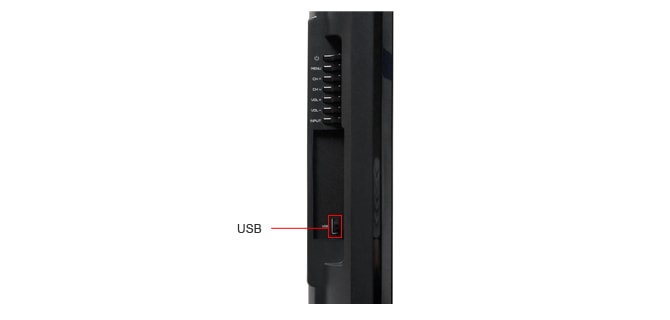
To its credit, though, it does retain some analog options that are increasingly often eschewed by newer TVs in favor of internet content and increased external media options. Still, its ports are fairly basic and few in number.
{{product.manufacturer_specs['Connectivity Tour Image 3']}}
Placement
{{section_header}}{{section.name}}{{/section_header}}
This score is hurt because the base does not swivel, but overall the placement of ports is difficult to mess up. Even though the rear ports are a bit difficult to reach in the back without physically moving the set, the side-facing input panel is a nice touch, and there aren't any oddly-oriented ports facing downward.
Audio Quality
{{section_header}}{{section.name}}{{/section_header}}
Most people would rarely mistake TV audio for a surround sound system, and the Sony KDL-46BX420's audio is about as far as you can get from that. With two 8 watt speakers, you shouldn't expect sound rivaling that of a true 5.1 channel surround sound system, or even a set of cheap iPod dock speakers. Surprisingly enough, there is a mostly-full equalizer to adjust the sound settings manually, which is a nice touch, but ultimately only useful if you use external speakers of some kind (which we recommend for users who own this TV set).
Menu Interface
{{section_header}}{{section.name}}{{/section_header}}
You can't get much simpler than the minimalistic menus of the Sony KDL-46BX420, but that's not a bad thing at all: the interface is clean and attractive, as well as functional. There aren't any distracting design elements or windows that obscure continuity from one menu window to the next, making for a good system.

The submenus all follow the same format as the picture adjustment menu above, with a descending list of features that are easy to follow and adjust.

Instruction Manual
{{section_header}}{{section.name}}{{/section_header}}
The manual of the Sony KDL-46BX420 is nice. Not thrilling, but nice. The format is well-laid out and easy to follow. It has no tabbed browsing, but the index is helpful, and the diagrams are informative. The language is overcomplicated in some places and overly simplistic in others, but in general it will tell you just about everything you need to know, but Sony certainly could have done more to prevent readers from falling asleep while staring at a wall of text. You can find the Sony KDL-46BX420's manual online here.

A manual for so many TV models, they have to be further categorized by type.
Internet Features
{{section_header}}{{section.name}}{{/section_header}}
The Sony KDL-46BX420 has no internet connectivity, and therefore no internet features or DLNA support. For that, you would need to construct yourself an HTPC or other streaming device and connect it via an HDMI cable.
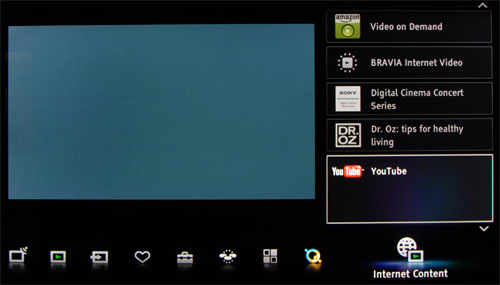
Local Media Playback
{{section_header}}{{section.name}}{{/section_header}}
The Sony KDL-46BX420 has a few options in the way of local media playback via the single UDB port on the side: .mp3 playback for music, MPEG playback for video and .jpeg playback for photos. Unfortunately, the KDL-46BX420 does not support any other file types, so if you're planning on making a slide show for a party, or play music through the TV's admittedly weak speakers, you're going to need to either convert your files or break the DRM on your .mp3s,_Protected_AAC,_WMA_to_MP3,_WAV,_WMA so they can play. If you're worried about the legality of this, fear not: what you buy is yours to do with as you please.
The Sony KDL-46BX420 has a very simple media playback interface that doesn't really change from one media type to another.
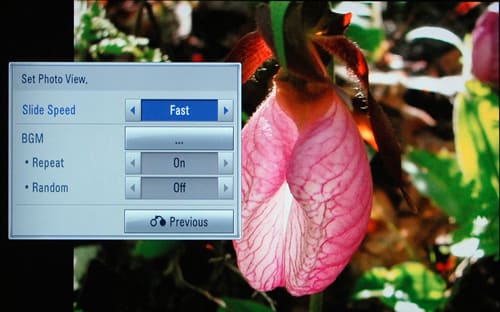
Other Media
{{section_header}}{{section.name}}{{/section_header}}
The Sony KDL-46BX420 does not support any additional media.
Power Consumption
{{section_header}}{{section.name}}{{/section_header}}
As stated in the section summary, the CCFL backlighting of the Sony KDL-46BX420 is less efficient than the newer LED edge/backlighting, so that means a higher power draw. In the end, we're not talking about a large gross cost of operation, but it's still something that's good to be aware of. By keeping the backlight setting at 5 (which puts the brightness at 200 cd/m2), you can expect to pay somewhere around $22.90 a year under normal use. To see how it functions under other settings, we've included a nifty chart that tracks all the power consumption data we collected.
As you can see from the graph below, this is a fairly standard power draw among LCD TVs.
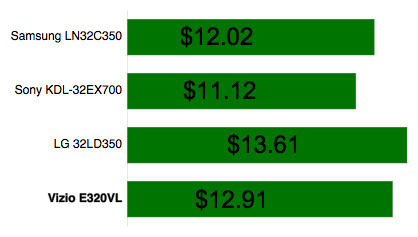
Value Comparison
{{section_header}}{{section.name}}{{/section_header}}
Both the Sony KDL-46BX420 and the Samsung LN46D550 are similarly-priced 2011 LCD TVs with similar specifications. The similarities end when you look at performance and features, however, as there are some pretty clear tradeoffs when you choose one over the other. If you want picture performance, the Sony is the better bet, while the Samsung offers much more in the way of connectivity options and internet connectivity.
Blacks & Whites
{{section_header}}{{section.name}}{{/section_header}}
Don't read too much into the difference in contrast ratio between the two sets, because they both have excellent contrast ratios and black levels. Both have peak brightnesses well over 200 cd/m2, which is more than enough for viewing in a well-lit room, and you really can't go wrong with either TV set in this comparison.

Color Accuracy
{{section_header}}{{section.name}}{{/section_header}}
Both TVs had similarly low levels of color temperature error, but the Samsung LN46D550 does have a more substantial spike in color temperature towards the darkest end of the range of signal intensity. In terms of RGB performance, both sets had relatively similar responses.
Motion
{{section_header}}{{section.name}}{{/section_header}}
Both sets are about as close as you come in terms of motion performance, but the Sony KDL-46BX420 has a slightly worse problem with artifacting than does the LN46D550.
Viewing Effects
{{section_header}}{{section.name}}{{/section_header}}
Neither TV has a viewing angle anybody aside from marketing execs would call "good," but the Sony KDL-46BX420 has a slightly wider one.
Connectivity
{{section_header}}{{section.name}}{{/section_header}}
In terms of connectivity options, the internet capability and greatly expanded connections of the LN46D550 are much more attractive to media junkies than what is available on the Sony KDL-46BX420.
Value Comparison
{{section_header}}{{section.name}}{{/section_header}}
Even though the TC-L42E30 has a higher price tag, you aren't paying extra for nothing: the smaller Panasonic carries quite a connectivity punch when it comes to internet content, where the KDL-46BX420 has none. If you don't care so much about that, the Sony brings a bigger (in every dimension) screen and vastly better picture quality.
Blacks & Whites
{{section_header}}{{section.name}}{{/section_header}}
The Sony KDL-46BX420 wins this one hands-down, as it scores better in every single measurement taken in this category than the TC-L42E30. In terms of overall performance, the TC-L42E30 actually has a rather poor showing in terms of blacks and whites, while the Sony KDL-46BX420 has an outstanding one.

Color Accuracy
{{section_header}}{{section.name}}{{/section_header}}
Neither TV set displayed much in the way of perceptible color temperature error, but the TC-L42E30 did have a much more dramatic cooling than the Sony KDL-46BX420 towards the darkest end of the graph. In terms of RGB performance, there really wasn't much difference between the two TV sets, as you can see from the color strips below.
Motion
{{section_header}}{{section.name}}{{/section_header}}
Neither TV impressed in the motion category, and scored extremely closely to each other.
Viewing Effects
{{section_header}}{{section.name}}{{/section_header}}
Don't believe this chart about the Panasonic TC-L42E30's "good" viewing angle for a minute. While it may appear that it has a wide viewing angle, it only recorded one at a very precise vertical angle that is smaller than most human eyes. We found that if you view the screen from even a couple degrees off-center vertically, the contrast ratio would drop below 50% of maximum, and the necessary positions in a room to take advantage of the theoretically large viewing angle are almost impossible to attain. Conversely, vertical viewing angle doesn't matter so much with the Sony KDL-46BX420, so what you see is what you get.
Connectivity
{{section_header}}{{section.name}}{{/section_header}}
Like all the other comparison model TVs, the Panasonic TC-L42E30 offers much more in the way of connectivity options via internet connectivity and a larger number of input and output ports, as you can see below.
Value Comparison
{{section_header}}{{section.name}}{{/section_header}}
Depsite the difference in price tag, there really isn't a whole lot different between these two TV sets aside from two major tradeoffs: the Sony has great picture quality but few connectivity options, and the LG has almost double the viewing angle of the Sony. Really, unless you absolutely need the one extra inch of screen space, or can find the LG for cheaper, the Sony will probably be a better buy than the LG 47LD4500.
Blacks & Whites
{{section_header}}{{section.name}}{{/section_header}}
The Sony KDL-46BX420 is a hard act to follow in terms of black and white performance, and the LG's awful black level hurts not only its contrast ratio, but its overall score, despite its unusually high peak brightness.

Color Accuracy
{{section_header}}{{section.name}}{{/section_header}}
The LG showed a consistently higher level of color temperature error throughout the range of signal intensity, where the Sony KDL-46BX420 only had a short peak or two that made it into the range of human perceptibility. RGB performance was very similar between the two models.
Motion
{{section_header}}{{section.name}}{{/section_header}}
Neither set dazzled in terms of motion performance, but they scored relatively closely in our tests.
Viewing Effects
{{section_header}}{{section.name}}{{/section_header}}
As you can see from the chart below, the LG 47LD4500 has the better viewing angle, able to display an image with 50% or more of its ideal contrast ratio up to 32 degrees from center on either side.
Connectivity
{{section_header}}{{section.name}}{{/section_header}}
Though both the LG 47LD4500 and the Sony KDL-46BX420 are similar in their connectivity options, they vary slightly, as can be read about below:
Conclusion
Overall, the Sony KDL-46BX420 ($899 MSRP) isn't a bad television set. Not only does it have great picture performance, but it isn't overly-complicated by features that would probably never get used, or only serve as a frustration. The lack of input ports may be an issue for some users, though, but it's fairly obvious that this TV was not designed with the high-end user in mind.
The KDL-46BX420 does fit the role of budget performance buy very well, and in terms of picture performance, you will get a great value for your dollar at the cost of additional features. As with most entry-level sets, it's not surprising that you will have to make choices in what you want in a television set before you buy.
Model Series Comparison
{{section_header}}{{section.name}}{{/section_header}}
The Sony KDL-xxBX420 series has three television sets, as listed below. All of them are entry-level LCD screened 1080p HDTVs with similar features.
Photo Gallery
{{photo_gallery "Front Tour Image", "Back Tour Image", "Sides Tour Image", "Stand Photo", "Controls Photo", "Remote Control Photo", "Connectivity Tour Image 1", "Connectivity Tour Image 2", "Connectivity Extra Photo", "Menu Main Photo", "Menu 2 Photo", "Internet Features 1 Photo", "Internet Features 2 Photo", "Internet Features 3 Photo", "Local Media Playback 1 Photo", "Local Media Playback 2 Photo"}}
Ratings & Specs
{{manufacturer_specs_table}}
Meet the tester
A seasoned writer and professional photographer, Chris reviews cameras, headphones, smartphones, laptops, and lenses. Educated in Political Science and Linguistics, Chris can often be found building a robot army, snowboarding, or getting ink.
Checking our work.
Our team is here for one purpose: to help you buy the best stuff and love what you own. Our writers, editors, and lab technicians obsess over the products we cover to make sure you're confident and satisfied. Have a different opinion about something we recommend? Email us and we'll compare notes.
Shoot us an email
